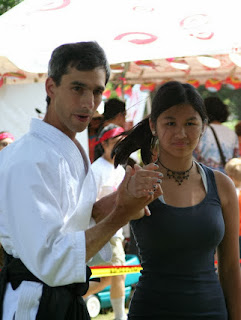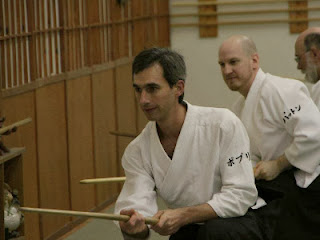A few years ago, I was attending a Ki-Aikido seminar in Lawrence,
KS, taught by Christopher Curtis Sensei—the chief instructor of the
Hawaii Ki Federation. Curtis Sensei is an excellent mentor. He is a
superb model of mind-body unification, he is keenly observant, and he
is skilled at exposing a students edge. At this particular seminar,
Curtis Sensei exposed a very raw edge of mine that was affecting my
training, my teaching, and my daily life.
Curtis Sensei had brought me up in
front of the group to demonstrate the Ki-Aikido technique he had been
teaching. I did my best, which I thought was decent though far from
perfect. I waited for Curtis Sensei's corrections and was looking
forward to his guidance on how I could improve. He turned to the
group and asked, “What did you think?” No one said anything, but
their body language spoke volumes. Nearly everyone was shifting back
and forth and looking up with quizzical, skeptical, slightly strained
expressions. They seemed to all be saying, “There is something off,
but I can't quite put my finger on it.”
Curtis Sensei easily read their silent
communication. “I know why your all having trouble,” he said in
his warm, baritone voice, “it's because Jon is so good... at making
it look right.”
Then Curtis Sensei looked over at me with a big smile on his face and
said, “with one hand he giveth, and with the other he taketh away.”
We all laughed. But Curtis Sensei was giving me an important lesson
in that moment—one that has continued to deepen for me in the years
since.
I am
good at making it look right. In
fact, I have given a lot of attention over the years to making things
look right. After all, my students learn by watching me—I need to
show them what the techniques we do are supposed to look like. What
Curtis Sensei was showing me in that moment, however, was how much I
had gotten caught up in outward appearance. I knew there was
something wrong with my technique, but rather than diving in and
looking for the source of the problem myself, I focused on the outer
form—trying to make it look right.
Over
the years, I have looked at where else in my life I get caught up in
the outer form at the expense of substance. Not surprisingly, it
showed up all over. It showed up in my writing, in my teaching, in my
relationships, in how I looked after my house and my car. But the big
eye opener came for me as I started to ask why. Why was I so driven
to make things look right?
The answer was obvious, if unpleasant. I was more concerned
with getting credit and praise than with actually producing results.
 A few months after the seminar with Curtis Sensei, I went out on a date with a wonderful woman named Meredith. I was quite enamored with Meredith and unconsciously fell into the habit of showing off for her. I wanted to earn her attention. This was, not surprisingly, a huge turn off. After a few dates, she told me she wasn't interested in pursuing a deeper relationship and wanted to keep our friendship casual. Fortunately, Curtis Sensei's teaching was still fresh in my mind and I was able to see what I was doing. I realized that Meredith had already offered her time and attention to me freely. I was saw that I was disrespecting the gift of her time by continuing to vie for her attention. I saw that I was—as Curtis Sensei put it to me so bluntly—being vapid. I shared all this with her, apologized for being a show-off and for trying to earn her attention and praise, and thanked her for sharing her time with me so generously. A year later we were married.
A few months after the seminar with Curtis Sensei, I went out on a date with a wonderful woman named Meredith. I was quite enamored with Meredith and unconsciously fell into the habit of showing off for her. I wanted to earn her attention. This was, not surprisingly, a huge turn off. After a few dates, she told me she wasn't interested in pursuing a deeper relationship and wanted to keep our friendship casual. Fortunately, Curtis Sensei's teaching was still fresh in my mind and I was able to see what I was doing. I realized that Meredith had already offered her time and attention to me freely. I was saw that I was disrespecting the gift of her time by continuing to vie for her attention. I saw that I was—as Curtis Sensei put it to me so bluntly—being vapid. I shared all this with her, apologized for being a show-off and for trying to earn her attention and praise, and thanked her for sharing her time with me so generously. A year later we were married.This November, Curtis Sensei is coming back to Lawrence to teach again. I am looking forward to the seminar, and looking forward to having a new edge exposed in my training.


